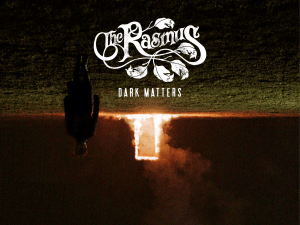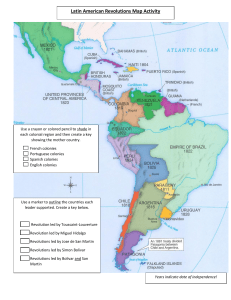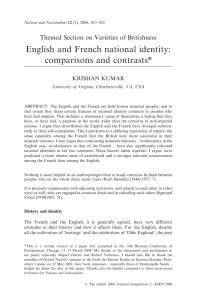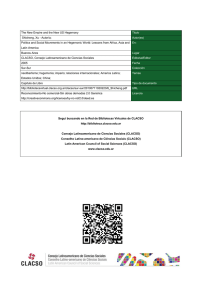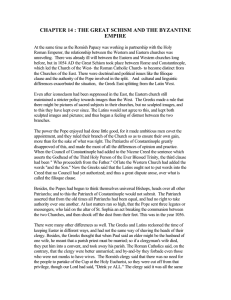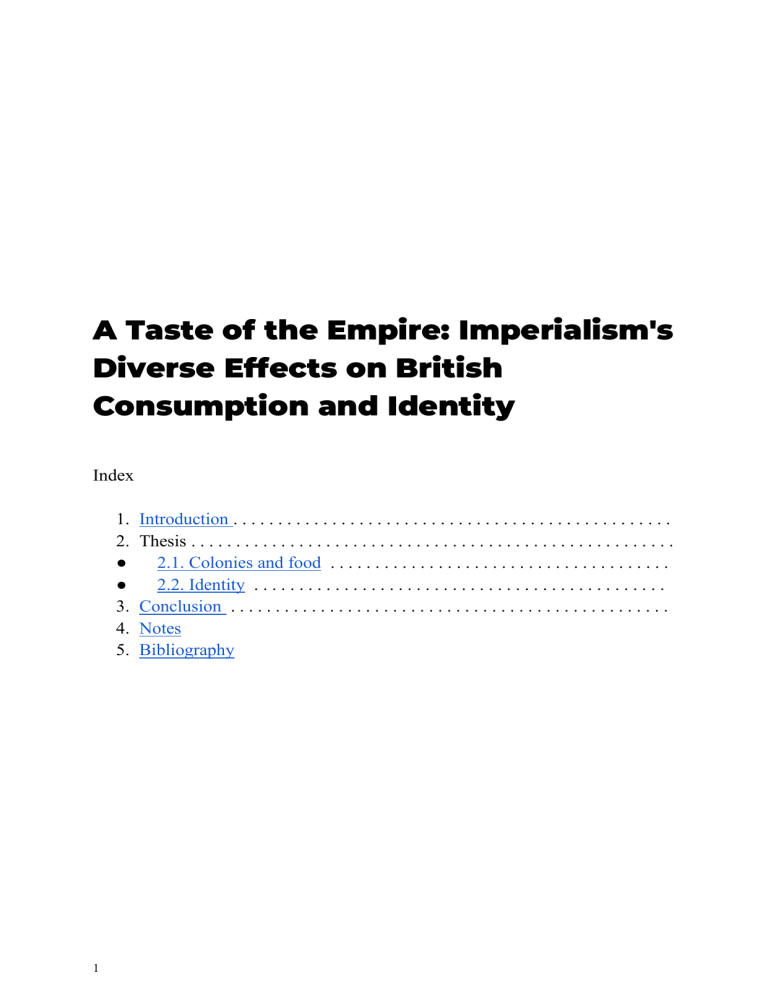
A Taste of the Empire: Imperialism's Diverse Effects on British Consumption and Identity Index 1. Introduction . . . . . . . . . . . . . . . . . . . . . . . . . . . . . . . . . . . . . . . . . . . . . . . . . 2. Thesis . . . . . . . . . . . . . . . . . . . . . . . . . . . . . . . . . . . . . . . . . . . . . . . . . . . . . . ● 2.1. Colonies and food . . . . . . . . . . . . . . . . . . . . . . . . . . . . . . . . . . . . . . ● 2.2. Identity . . . . . . . . . . . . . . . . . . . . . . . . . . . . . . . . . . . . . . . . . . . . . . 3. Conclusion . . . . . . . . . . . . . . . . . . . . . . . . . . . . . . . . . . . . . . . . . . . . . . . . . 4. Notes 5. Bibliography 1 How we dress and what we consume have been tightly related since the beginning of time. not just goods but also services, food, experiences, and even people. This has been tremendously exacerbated by the rise of big capitalism and the culture of rapid consumption, which affects practically everything we consume. As a result of the British Empire's extensive worldwide reach, all of those colonies began to influence British consumption patterns. The subject of how the Empire established (and still defines) British consumerism and, consequently, how people live will be examined in this article. The British Empire's lasting legacy has a significant influence on modern British consumerism and, in turn, the lives of its citizens. This essay will show that this viewpoint ignores the deeply ingrained power dynamics and inherent inequalities that structured imperial trade and continue to resonate with contemporary consumption patterns, despite some scholars' claims that the Empire's contribution to British consumerism is primarily one of enrichment through the introduction of diverse goods and culinary traditions. With its extensive influence on international trade, culture, and demographics, the British Empire's legacy continues to influence modern British life, especially in the area of consumption. British consumers' habits, tastes, and ultimately their way of life were altered by the importation of goods, people, and ideas from the colonies. The Empire's iconic symbol endures, posing issues about its role in forming contemporary British identity and consumer culture, from the omnipresent cup of tea to the intricate complexities of multiculturalism. This essay makes the case that even though the Empire's direct impact may have diminished, its legacy nevertheless shapes daily life, defines British consumerism, and reinforces intricate ties to the past. 2 So, to what extent can the integration of colonial commodities and cultural practices into British society be seen as a reciprocal cultural exchange, rather than a one-sided process of assimilation and exploitation, given the agency of immigrant communities and the evolving redefinition of 'Britishness' in a postcolonial context? The most noticeable and long-lasting legacy is the integration of colonial commodities into British daily life. Once exotic and unobtainable, tea, sugar, spices, and tropical fruits have become staples of the British diet, changing culinary customs and palates. Even if its roots are rooted in the colonial enterprise, the ritual of afternoon tea, for example, with its intricate protocol and imported food, became an accessible symbol of Britishness. This normalization process, in which Empire products are effortlessly assimilated into British society, obscures the historical background of exploitation and unequal power relations inherent in their acquisition. For instance, the pleasure of a cup of tea seldom prompts contemplation of the plantation systems, forced labor, and international trade networks that got it to the British table. In addition to food, the Empire influenced material culture and aesthetic preferences, developing concepts of elegance and taste. Textiles, furniture, and ornamental items from the colonies became highly sought-after commodities, denoting luxury and worldliness, and were frequently made with complex designs and exotic materials. Popular West African wood carvings, Chinese porcelain, and Indian fabrics fueled the emergence of unique aesthetic movements including Orientalism and Chinoiserie, which influenced British design and fashion forces in their respective eras. However, this appropriation of colonial aesthetics frequently involves a process of decontextualization and anarchicization, stripping items of their unique cultural meanings and turning them into emblems of British cultural supremacy and imperial power. British consumption patterns were further diversified by the inflow of immigrants from the colonies, who brought new clothing, culinary customs, and cultural activities. The British 3 culinary environment was enhanced by the influx of new flavors, ingredients, and cooking methods brought about by the establishment of immigrant groups from the Caribbean, South Asia, and Africa. For instance, curry shops have become a common sight on British high streets, acting as social and gastronomic hubs for immigrant populations while also bringing British cuisine to the many South Asian cuisines. However, concerns about cultural authenticity, appropriation, and the shifting face of British identity surfaced, making this cultural interchange not always harmonious. For example, discussions about "authentic" curries highlight the intricate processes of cultural interchange, appropriation, and identity negotiation within a postcolonial setting. Beyond tangible goods and services, this legacy has shaped intangible facets of British culture, such as leisure, travel, and identity concepts. For example, imperial discovery and the romanticization of far-off places gave rise to the idea of "exotic" travel, which fueled the growth of the tourist sector and influenced how people perceived foreign cultures. Travel to former colonies, which are frequently promoted as adventures and exploration, maintained a sense of British ties to these locations while frequently ignoring the historical legacies of colonialism and its current effects. This intricate relationship between nostalgia, tourism, and imperial history highlights the Empire's continuing impact on British conceptions of the world and their place in it. Through the creation of international commerce networks and infrastructure, the Empire also influenced British consumption. For instance, the East India Company created extensive commercial networks that linked Britain to markets in Asia, Africa, and the Americas, promoting the flow of products and aiding in the growth of consumer capitalism. Global trade was further aided by the construction of ports, shipping routes, and banking institutions, which increased the British public's access to and affordability of imported goods. Since the UK is 4 still a key player in international trade and depends on worldwide supply chains to meet the demands of its consumer market, this infrastructure of global trade, which was constructed during the Empire, continues to impact current British consumerism. This history has had a clear and significant influence on British culture and lifestyle. A large portion of what the rest of the world associated with Britain does not originate there, and both the genesis and the primary production occur abroad. In addition to incorporating elements of other cultures until they become emblematic, being mindful of cultural distinctions also serves to strengthen one's sense of self. Take, for instance: “I just love it. I love it because it's different — a little taste of something more exotic... Most days I might have an Indian meal, or a Thai meal or a Chinese meal, or a vegetarian take-away, or pasta. I never just have a chees omelet, never, it's boring.”1 (May 1996a:61) Despite the end of the Empire's direct political and economic dominance, its cultural and social legacy endure, influencing modern British consumers in subtle and complex ways. Its deep and persistent influence on British life is demonstrated by the consumption of colonial commodities, the influence of imperial aesthetics, the diversity of gastronomic and cultural activities, and the enduring interest in visiting former colonies. Understanding the dynamics of modern British consumer culture and critically analyzing the intricate connections between consumption, identity, and the lingering influence of the past requires an awareness of these legacies. To conclude, the argument over how the Empire affected British consumption is still hotly contested. There are many who contend that emphasizing imperial legacies fosters a romanticized perspective of the past, hiding the brutality and exploitation inherent in colonial control. Others stress the importance of acknowledging these legacies in order to comprehend 5 the intricacies of contemporary British society and alleviate the persistent disparities resulting from colonial history. Whatever one's position, the Empire's indisputable influence on British consumerism demands a critical analysis of the past and its ongoing impact on modern society. Notes 1. “Geographies of consuption.” 2001. In British Cultural Studies: Geography, Nationality, and Identity, edited by David Morley and Kevin Robins. N.p.: Oxford University Press. Quote. Bibliography “Geographies of consuption.” 2001. In British Cultural Studies: Geography, Nationality, and Identity, edited by David Morley and Kevin Robins. N.p.: Oxford University Press. Lloyd, Amy J.: “The British Empire.” British Library Newspapers. Detroit: Gale, 2007. https://www.gale.com/binaries/content/assets/gale-us-en/primary-sources/intl-gps/intl-gpsessays/full-ghn-contextual-essays/ghn_essay_bln_lloyd4_website.pdf 6

